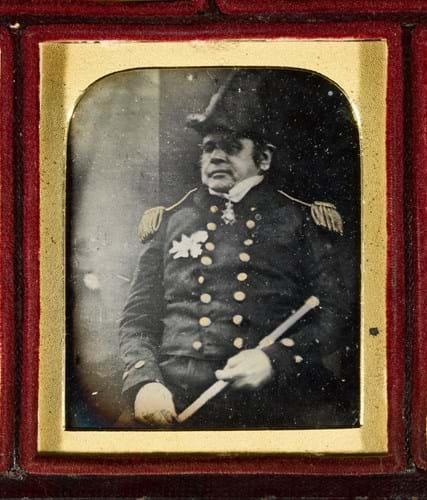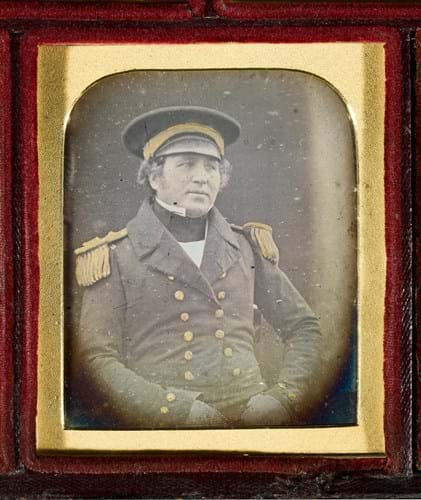
The 14 daguerreotypes of Sir John Franklin and his fellow senior officers before they left for the ill-fated expedition.
The collection of 14 daguerreotypes come from the direct descendants of Commander Sir John Franklin and will be estimated at £150,000-200,000 at the auction on September 21.
Dubbed “one of the most significant rediscoveries for the history of photography and polar exploration”, the collection was originally commissioned by Lady Jane Franklin and taken en plein air aboard HMS Erebus just three days before it was to set sail, never to return.
The images, taken by Richard Beard studio on May 15-17, 1845, are the last photographs of 14 members of the expedition.
The ill-fated voyage to explore 500km of Artic coastline to complete the charting of the Northwest Passage – a vital sea route between the Atlantic and Pacific oceans – ended in tragedy when both ships became stuck in the ice and eventually all its 24 officers and 110 crew perished.
The worst disaster in the history of British polar expeditions, dozens of subsequent explorations were launched to discover what had happened to Franklin and his crew.
The 14 sixth-plate daguerreotypes, each hand-tinted coloured with shell gold applied to the buttons, hat bands and epaulettes of the officers' jackets and each inscribed with the details of the sitters, were unknown to the wider world until recently.
The only other known set of the daguerreotypes is in the collection of the Scott Polar Research Institute (SPRI) in Cambridge but this set lacks the images of Robert Sargent and Captain Francis Crozier.
Emily Bierman, global head of Sotheby’s Photographs department, said: “A true monument in the history of photography, these haunting daguerreotypes are among the most important examples of 19th century photographs to ever appear at auction. Each plate is stunningly crisp and conveys the high level of detail the best daguerreotypes are known for. Their re-emergence after 178 years is a truly significant moment for the market and our understanding of the medium.”
Dr David Goldthorpe, head of Sotheby’s Europe Books & Manuscripts department, said: “Apart from its broader significance, it is worth remembering the private dimension that this set of images holds. Franklin’s family must have known that the safe return of the 59-year-old Sir John was no certainty. It is when viewed as a private keepsake, rather than as a public record, that the human stories beneath these images truly come alive.”
Reward seekers
Supplied with three years’ worth of preserved food supplies, The Franklin Expedition set sail from Greenhithe on May 19, 1845, with a crew of 24 officers and 110 men.
With no word from them, eventually Franklin’s wife offered a reward, equal to £2m today, and many failed searches took place, with more men and ships lost than in the expedition itself.
In 1854, the Scottish explorer John Rae determined the fate of the expedition by talking to Inuit hunters during his survey of the Boothia Peninsula for the Hudson’s Bay Company.
Both ships had become icebound with the men dying from the cold and in some cases resorting to cannibalism. The news caused widespread anger in Victorian society.
Lady Franklin's determined efforts to find her husband led to a further 25 searches over the next four decades, which although did not add further information in locating her husband, contributed hugely to the mapping of the Arctic.
In 2014 HMS Erebus was remarkably discovered by Parks Canada in collaboration with Inuit communities, followed by the discovery of HMS Terror in 2016. These marked two of the most important polar archaeological finds in recent history.
Many of the objects discovered during these missions are now held in the National Maritime Museum.







